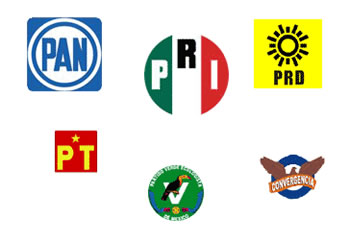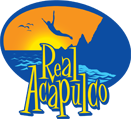Mexico's Political Parties

In 2000 the color of the PRI's logo became a major issue. It is red, white, and green -- the colors of the national flag. This caused opposition candidates to fear that the less educated or uninformed voters would be confused and just "vote the flag," giving away votes for the PRI. The PRI dominated Mexico's de facto one-party political system for decades, from the 1930's to the 1990's.
Mexico currently has about a dozen political parties, many of which come and go. This may seem like a lot until one realizes that even the US has far more parties than the Democrats and Republicans. In Mexico, as in the US, only a few of these groups are real political players and merit a mention.
Mexico was a single-party state until in the late 1980's, when party competition began to emerge at the local levels of government. Democracy in Mexico spread from cities to states, and then finally to the national level with the victory of PAN candidate Vincente Fox in 2000. The transition was consolidated with the victory of PAN candidate Felipe Calderón in 2006, in a hotly contested election against the PRD candidate, Andrés Manuel López Obrador.
For all practical purposes, Mexico is a three party system.
PRI
PRI - the PRI, which stands for Partido Revolucionario Institucional (Institutional Revolutionary Party) ruled Mexico single-handedly for about 70 years. The roots of the PRI were indeed revolutionary and were embodied in the populist spirit of Lázaro Cárdenas, who was foremost in pushing Mexico down a path of economic nationalism, particularly with the nationalization of the petroleum industry and the creation of PEMEX, the mega state-run oil company that continues to be a symbol of Mexican sovereignty, independence and corruption. The PRI was founded on the back of unions, peasants, and the military, with the support of the middle sectors, who rejected the traditional power bases of the church, business groups, and the US State Department. The PRI, however, grew bloated and corrupt.
Indeed, corruption is today the term still most widely associated with PRI rule, particularly after the controversial presidency of Carlos Salinas de Gortari (1988-1994)
.With the loss of the presidency in 2000, the PRI was widely thought to have fallen apart. But to the surprise of most political scientists, the PRI has made a comeback. Today it remains well-represented in the national assembly, and the party holds many state governorships. The PRI is especially strong in the rural sectors, among unions, and in the "backward" southern states of the country, Guerreo among them.
PRD
PRD - Partido de la Revolución Democrática (Democratic Revolutionary Party) was born during the 1988 election when the left wing of the PRI split in protest to the selection of Carlos Salinas' party insiders for the next PRI presidential campaign (presumably assured of election into the next presidential administration). It was widely held to be the left's turn to have their choice be the next president. The PRD was quickly formed as the personal vehicle of the candidate of choice by the party's left wing, Chautemoc Cárdenas. He was the son of Mexico's famous populist leader and PRI luminary, Lázaro Cárdenas. He stood for election as a challenge to Salinas and all that he represented. The premise of the PRD was that the PRI had moved too far to the political right and had abandoned, if not betrayed, its revolutionary origins.
In the presidential contest of 1988, Cárdenas was widely believed to have won the election. The central election computers "went down" with Cárdenas well in the lead. When they returned, Salinas had opened a sizable lead. Since that election, the PRD has coalesced into a strong national party with a lineage of capable leaders.
The PRD is Mexico's liberal party, favoring nationalistic economic policies, a nominal preference for protecting and serving the poor, social liberalism, and, in particular, women's rights.
PAN
PAN - Partido Acción Nacional (the National Action Party) was the official opposition during the years of PRI domination and phony elections. The PRI held regular elections, in which they always controlled the outcome; however, they needed an opposition party to create the appearance of an election. The PAN served this function. In the 1980s, the PAN began to become a more strident contender, winning elections at the local level in the northern states, and creating pressure for the 1986 Electoral Reform Law which created an opening for competitive politics. The PAN is a traditional conservative party, favoring a competitive, market economy, religion, and "traditional" social values. Its base is in the north, particularly in Monterrey and the border region.
In the state of Guerrero, and especially in Acapulco, the PRI and the PRD predominate, while the PAN only polls about 3% in statewide polls.
Other Political Parties
PT - Partido del Trabajo - Worker's Party - a traditional socialist workers party. Some presence in Guerrero and Acapulco.
PVE - Partido Verde Ecologista de México - Mexico's Green party, but with problems with sticking to their green ideals. This is no Ralph Nader organization. It usually allies itself with the PRI.
CONV - Convergencia (the Convergence Party) - a loose knit party promoting democracy and national development. Some presence in Guerrero and Acapulco.
The other parties and contact information for all can be seen here.
IFE
IFE - Mexico's Federal Election Institute - for more information about Mexican politics and particularly voting and Mexico's transition to democracy, this is the first place you should stop.

